Lecture 3
Types of trends, types of charts and formation rules. Bull and bear speculations.
Let us consider the main question of Forex and any other trading – how to earn money?
The point is that prices tend to move, we can often observe in everyday life that price for any product is rising, falling or keeping up at the same level, making insignificant fluctuations. Such features of prices are called trends. Obviously if prices are rising then it is ascending trend, if they are falling, then it is descending trend and if they are keeping up, then it is sideways trend. Just this very characteristics of price movement gives an opportunity to get profit. What should we do to earn money when prices are moving up? – Probably buy this product or, like financier says, asset, and sell it when the price go up, and get profit. And if does the price move down? – Then sell for higher price and buy when the price will fall down. The question “How can we sell the thing you do not have” is a peculiar question and we will talk about it during the next lections. Now let’s study processes described above. Buying of asset and its further selling is called “Bull speculation”, and selling with further buying of asset is called “Bear speculation”. Usage of “bull” and “bear” in describing of markets comes from the way each animal attacks its opponent. That is, a bull thrusts its horns up into the air, and a bear swipes its paws down. These actions are metaphors for the movement of a market: if the trend is up, it is considered a bull market. And if the trend is down, it is considered a bear market.
I hope that after you had downloaded the trading terminal InstaTrader, you read and examined manual for trading terminal MetaTrader. We will use this program starting with this lection for more efficient study of teaching material and improving the practical skills. So download the program and open the window with chart of any currency pair.
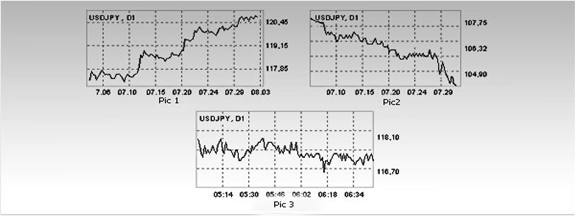
At the first chart you can see gradually rising line. This movement is not unidirectional, it alternate with highs and lows, but directed upwards. In this case chart reflects price change of 1 USD against JPY. Though price of 1 USD was lower than 117.85 JPY before July 15, however to August 3 1 USD costs 120.45 JPY, that means ascending trend took place or “Bull trend”. That is why it is necessary to buy US Dollars for Japanese Yen – Bull Speculation”. Let’s count: if we bye 1 USD for 117.85 JPY and then sell for 120.45 JPY, then the difference would be 2.6 JPY or 0.02 USD. Absolute value of these figures does not impress, but if we suppose that dealing was executed with 100 000 USD, then impression will be another – 2000 USD of profit for 18 days is not that bad. Moreover it corresponds to 40.5 % of annual profit. No one bank gives you such interest.
There is another situation at the second chart. The line which reflects price change of 1 USD against JPY is not unidirectional decreasing as well. It alternative with lows and highs so this situation makes us think it is descending or “Bear” trend. For getting profit trader should sell US Dollars for Japanese Yen, i.e. Bear speculation.
At the third picture we can see that chart line changing the direction, fluctuates in one range bounded with price levels 118.10 and 116.70. Such movement is called ”Flat”. In this case there is possibility to change tactic from “Bear” to “Bull”.
Moving in time price marks different characteristics of its movement in certain period of time. Such period can be from one minute to 1 month or even one year. The most important characteristics are opening price, high, low, closing price.
Opening price – the first price of asset at the given period (for instance, hour, day, week).
High – maximum price of asset at the given period
Closing price – the last price of asset at the given moment. Running ahead, I want to note that this price is more often used for analysis and considered as more significant.
There are many methods of price fluctuation plot on the chart and we will consider three the most popular ways.
Line chart.
Line chart is the simplest one displaying the chart as a broken line which can be constructed by one of the parameter – by opening price, closing price, highest price, lowest price and by middle price which is counted by bipartition of discrepancy between the highest and the lowest prices.
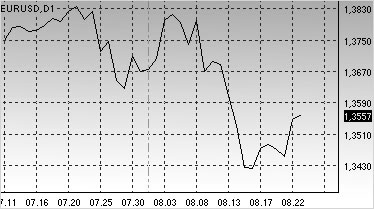
Pic. 4. Line chart
Bar is a vertical line segment. Opening and closing prices are market from the left and right side of this line. Scratch from the left side is opening price, scratch from the right side is closing price, highest point is maximum and lowest point of the bar is minimum prices.
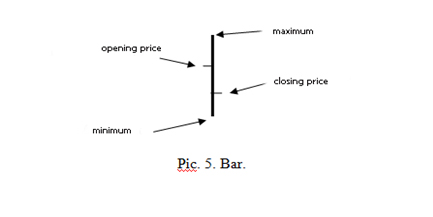
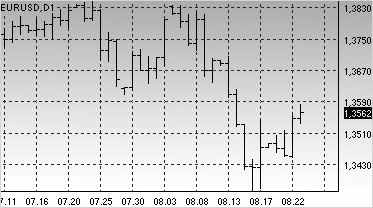
Pic. 6. Bar chart
Candlesticks.
Candlesticks chart resembles sequence of candlesticks with wicks from both sides. Candlestick consists of vertical rectangle which is called candlestick body and two lines placed above and under the candlestick body. These lines are called shadows. If closing price is higher than opening one, then candlestick is white (hollow). If closing price is lower than opening one, then candlestick is black (filled). The end of the upper shadow shows the highest price of given period, and the end of the lower shadow – minimum price.

Pic. 6. Candlesticks.
Classic image of the candlesticks is presented at given above schemes and charts. Such image is used in educational materials of these lectures. It is supposed that candlestick is against white background. If the color of the candlestick and background is the same then candlestick is hollow, if the color of the candlestick and background is different (background is white, candlestick is black or vice versa), then candlestick is filled.
So hollow candlestick represents rising market and filled one – falling.
Useful information for users of InstaTrader terminal InstaForex.
For the terminal: (background is black on default), is closing price is higher than opening one then candlestick is hollow; if closing price is lower, then candlestick is filled (white). We take into consideration this peculiarity and describe not only color of candlesticks but also its content, hollow or filled.

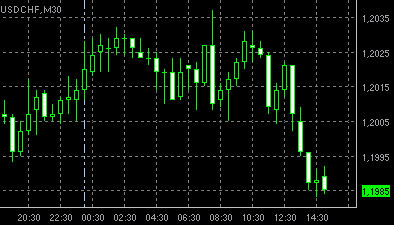
Pic. 7. Candlesticks
Test questions.
1. What is Bull speculations and Bear speculations? What cases are suitable for one or another strategy?
2. What types of price tendencies do you know?
3. What is the difference between Candlesticks and Bar?
Assignment for submission.
1. Open the chart window of EUR/USD currency pair in InstaTrader with time gap “days” (D1) and determine what tendency price move have had since March 2009.
2. Considering situation at the picture 1, we counted profit which would be in case of buying 1 US Dollar for Japanese Jena. Make similar calculation for the profit in situation at picture 2, if 1 US dollar was sold for 107.75 JPY and then bought for 104.90 JPY. The result should be in JPY and USD.
 English
English  Arabic
Arabic 